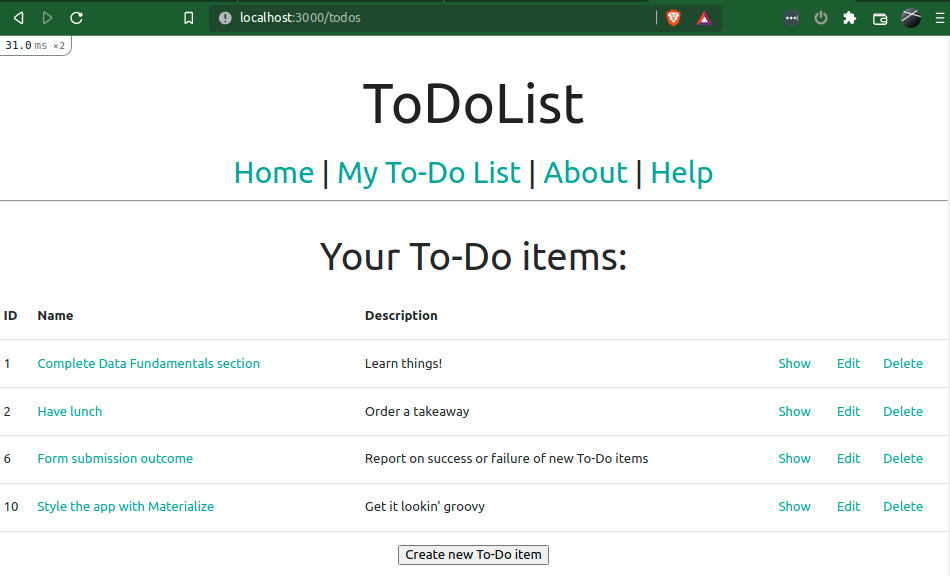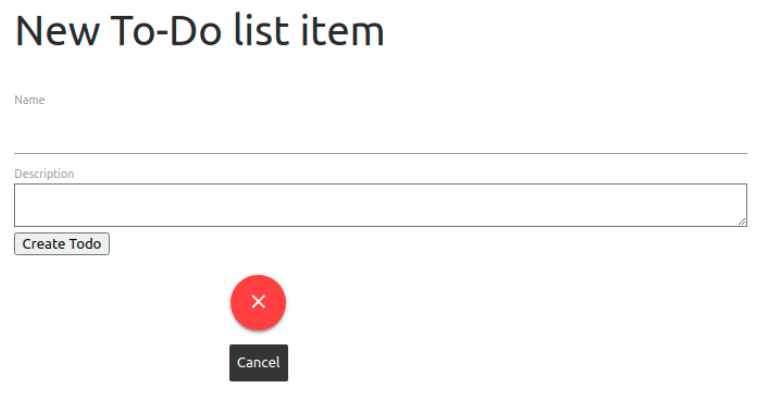[ToDoList] Hindsight Exercise (Generators)
Our ToDoList web app is certainly a beautiful thing, and has seen a lot of love as we've done most of the legwork manually. However, as mentioned several times throughout the guide, most of what has been done above can be bypassed with higher-level Ruby magic in the form of generators, which automated a great deal of the work.
This short section will outline which of the steps we've taken to create our app so far could have been automated in this way.
If you want to code along with this section, you can cd back into your projects directory and
create a separate Rails app (i.e. to_do_list2) to test these generators as we go along:
$ rails new to_do_list2
Our first step was creating our PagesController and its respective views, which seems so long ago now.
Doing this manually was extremely valuable to learn how each piece of the application knitted together,
but also to appreciate the power of the generator that could have done half the job for us.
The command below invokes the controller generator,
where we pass it the name of the controller (in CamelCase) as well as the actions/views that we want it to generate (in snake_case):
$ rails generate controller Pages home about help
create app/controllers/pages_controller.rb
route get 'pages/home'
get 'pages/about'
get 'pages/help'
invoke erb
create app/views/pages
create app/views/pages/home.html.erb
create app/views/pages/about.html.erb
create app/views/pages/help.html.erb
invoke test_unit
create test/controllers/pages_controller_test.rb
invoke helper
create app/helpers/pages_helper.rb
invoke test_unit
invoke assets
invoke scss
create app/assets/stylesheets/pages.scssWe can see from the output there that this generator has done an awful lot for us - if you ran this yourself go into each file and see what it has done:
-
It has created our
PagesControllerfile based on the initialPagesargument we passed.-
Also it has defined each of the actions we passed in as arguments afterwards:
home,aboutandhelp
-
Also it has defined each of the actions we passed in as arguments afterwards:
- It has generated basic routes for us in the config, which admittedly we would have to go in and change.
-
It has invoked
erbto create ourviewsdirectory and a file for each one we passed arguments for.- If you start the server and navigate to these pages, you will see some temporary HTML showing that it is working correctly, as well as where to go to change it.
- It has invoked the
TestUnitand created some basic integration tests for our routes. - It has added an (empty) helper module.
- It has generated a template for a stylesheet which can be used to make it pretty later on.
Our actual Todos development was a slightly more involved affair,
which required a database to be set up with an associated model on top of controllers and views.
You may recall we used a generator here to create a migration file to initially set up our database.
However Rails could have handled even more of this for us if we had used the model generator to do this instead:
$ rails generate model Todo name:string description:text
invoke active_record
create db/migrate/20210521143142_create_todos.rb
create app/models/todo.rb
invoke test_unit
create test/models/todo_test.rb
create test/fixtures/todos.ymlBy the output, we can again see that Rails has done a bit of the heavy lifting for us here:
-
It has invoked
ActiveRecordand has run the migration generator, which we did manually before to create our migration file. - It has created our basic (blank) model.
-
As with the controller, it has invoked the
TestUnitand populated some basic tests.- It has also generated a fixtures file, which will be used by the test when it is run.
Todo class
using
As for the controller, we know from before that the controller generator will create the controller actions,
as well as the views, based on the arguments we pass it.
But for some actions (i.e. #update, #destroy), we do not require a view.
In addition, it will create the routes that it calculates are required.
However in the case of the Todos,
we know that our magic resources line in the route config will provide all of the routes we need and
so we don't need the generator to provide any routes.
We will therefore need to run our controller generator only passing arguments for actions that we would like a view for, and an additional argument that will prevent it adding to the routes configuration to save us deleting it later:
$ rails generate controller Todos show new edit index --skip-routes
create app/controllers/todos_controller.rb
invoke erb
create app/views/todos
create app/views/todos/show.html.erb
create app/views/todos/new.html.erb
create app/views/todos/edit.html.erb
create app/views/todos/index.html.erb
invoke test_unit
create test/controllers/todos_controller_test.rb
invoke helper
create app/helpers/todos_helper.rb
invoke test_unit
invoke assets
invoke scss
create app/assets/stylesheets/todos.scssPages,
without the addition of the routes configuration lines.
All we need to do now is add our magic line into /config/routes.rb:
resources :todos#update),
in addition to the HTML that we need to perform our CRUD methods from the front end.
Obviously there were some bits generated in this section that we haven't covered previously, such as integration tests, helpers and stylesheets - we may cover these in a later section, however more information can be found in the Ruby on Rails guides at guides.rubyonrails.org.
Even if you choose not to look up these particular features,
it is hugely, massively recommended that you go through the Getting Started with Rails guide on this site,
which instructs on how to create a simple blog app using these generators (and you can see just how much of this guide I have plagiarised!).
This guide also adds several extra layers of complexity to the app, including nested comments, concerns and basic authentication.
It is very educational and very fun!
However there is one last thing I would like to show you regarding generators that, if you were impressed by what we've seen in this section so far, will leave you in an open-mouthed state of awe (again, this may have just been me).
| < [ToDoList] Deploy the App | | | [ToDoList] The Scaffold Generator > |
| Back | ||



Comments
Post a Comment